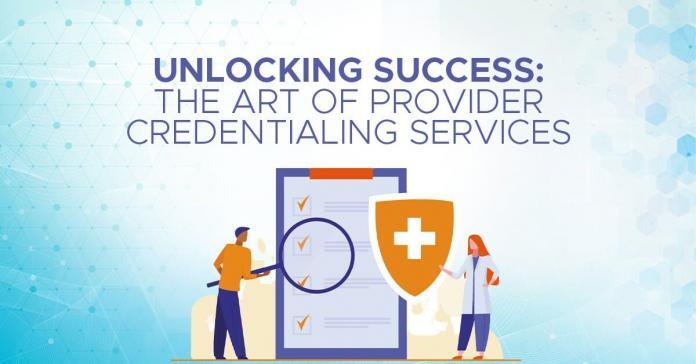It is impossible to overstate the significance of provider credentialing in today’s increasingly complex healthcare environment. Credentialing guarantees that medical practitioners have the training and experience to deliver high-quality treatment, which is crucial to quality assurance and patient safety. We will examine the complexities of provider credentialing in this blog, going over its importance, essential elements, difficulties, and potential outcomes.
Critical Steps Involved in Provider Credentialing
Gathering Provider Data
The first stage in credentialing is assembling detailed data about the provider, including their education, training, employment experience, licenses, certifications, expert references, and other pertinent credentials.
Primary Source Verification (PSV)
In this step, the accuracy of the information provided by the supplier is confirmed by consulting the original primary sources. Primary sources include academic institutions, certification agencies, licensing boards, and prior employers.
Sanctions and background checks screening
Credentialing services conduct extensive background investigations to determine if the provider has ever been the subject of malpractice lawsuits, disciplinary actions, criminal records, or sanctions. This procedure protects patients and lessens any hazards.
Peer References
Obtaining references from other medical experts who have collaborated with the practitioner is a part of the credentialing process. These peer references shed light on the provider’s professionalism, clinical expertise, and capacity for productive teamwork.
Privilege
Privilege awards a physician special clinical privileges based on their credentials, education, and experience. This stage guarantees that providers are qualified to offer particular operations or services that fall under the purview of their training.
Continuous Monitoring and Re-Credentialing
The process of obtaining credentials is ongoing. The qualifications of providers are routinely examined to ensure they are up to date and adhere to industry standards. Re-credentialing is done regularly to review and refresh provider qualifications.
Credentialing Committee Review
After completing the verification and assessment phases, a credentialing committee examines the data gathered, judges the provider’s suitability for credentialing, and renders a final determination.
Communication and Notification
The provider is informed of their credentialing status when the credentialing decision has been made. They are given privileges within the healthcare organization and can start working if accepted. The provider may be informed of any shortcomings or issues and given the chance to rectify them.
Credentialing Committee Review
After completing the verification and assessment phases, a credentialing committee examines the data gathered, judges the provider’s suitability for credentialing, and renders a final determination.
Communication and Notification
The provider is informed of their credentialing status when the credentialing decision has been made. They are given privileges within the healthcare organization and can start working if accepted. The provider may be informed of any shortcomings or issues and given the chance to rectify them.
The Significance of Provider Credentialing
Ensuring Patient Safety and Quality Care
Provider credentialing plays a critical role in ensuring patient safety by confirming that healthcare workers have the requisite training, expertise, and competence to provide high-quality care.
Mitigating Legal and Financial Risks
Credentialing assists healthcare organizations in reducing liability risks related to malpractice, misconduct, or fraudulent practices, safeguarding their reputation and financial stability. This is done by conducting thorough background checks and sanctions screening.
Conformity with Regulatory Requirements
To participate in insurance networks, receive reimbursement from programs, and uphold conformity with industry standards, many regulatory bodies, including governmental entities and accrediting bodies, require provider credentialing.
Establishing Trust and Confidence
Having credentials assures patients that their healthcare providers have been thoroughly examined, complied with professional norms, and acted ethically. The development of solid patient-provider interactions depends on this trust.
Maintaining Professionalism and Ethical Standards
Provider credentialing assesses a healthcare professional’s adherence to ethical standards, professional behavior, compliance with pertinent codes of conduct, and clinical competence.
Building Strong Networks of Qualified Providers and Encouraging Collaboration
Credentialing enables healthcare organizations to develop strong networks of qualified providers, fostering collaboration and facilitating easy referrals, ultimately increasing patient continuity of treatment.
Enhancing Organizational Reputation
The general reputation of healthcare organizations is enhanced through rigorous credentialing procedures. Affiliated with highly skilled and accredited healthcare professionals improves the organization’s standing in the medical community and draws in patients looking for dependable and knowledgeable care.
Adapting to Changing Healthcare Practices
Credentialing maintains up with changes in the healthcare industry by embracing new standards, technologies, and laws. In a healthcare setting that is constantly evolving, this adaptability guarantees that providers remain knowledgeable and competent.
Navigating Challenges in the Credentialing Process
Provider credentialing is a complicated and sophisticated process that may come with several difficulties. However, these difficulties can be overcome with the proper techniques and strategies. The following are some typical problems with the credentialing process and advice for resolving them:
Incomplete Provider Information
Providers occasionally need to provide complete or correct information, which can cause the credentialing process to take longer. Credentialing services should provide effective channels of contact with providers, give complete application forms, and provide instructions on necessary evidence to address this issue. Regular follow-ups and reminders can ensure the timely and proper submission of provider data.
Delays in primary source verification (PSV)
PSV contacts primary sources, including educational institutions and licensing boards, to confirm a provider’s credentials. The timeline for credentialing can be considerably impacted by delays in getting responses from various sources. Credentialing services should build trusting connections with primary sources, use electronic verification techniques when practical, and keep lines of communication open to speed up the verification process to address this issue.
Complex Regulatory Requirements
There are several regulatory requirements that the credentialing process must follow, and these requirements might change according to the region and the type of healthcare facility. Staying current with these regulations and ensuring compliance might be complex. To overcome these complications, credentialing services should devote funds to employee continuing education and training, keep a close eye on regulatory developments, and sustain solid relationships with oversight organizations.
Managing Credentialing Deadlines
To ensure prompt provider onboarding and participation, the credentialing process includes particular schedules and deadlines that must be met. Effective timeline management is essential. Credentialing services should build dependable project management methods, use software to track and monitor progress and create open lines of communication to keep all stakeholders informed and held accountable.
Keeping Up with Technological Advancements
The technology significantly impacts how easy it is to get credentials. However, keeping up with recent technological developments might take much work. Credentialing services should invest in contemporary credentialing software and tools, keep abreast of new products in the healthcare sector, and periodically review their operations to look for chances for technological advancement.
Maintaining Data Security and Privacy
Maintaining Data Security and Privacy is extremely important because credentialing entails managing sensitive provider and patient information. To protect sensitive data, credentialing services must develop strong data security measures, secure electronic document management systems, and maintain compliance with data protection laws like HIPAA.
Credentialing services may successfully traverse the credentialing process, eliminating delays, guaranteeing compliance, and providing top-notch services to healthcare organizations and providers by proactively tackling these difficulties and implementing effective methods.
Emerging Trends and Future of Provider Credentialing
Provider credentialing is constantly changing to keep up with the changing demands of the healthcare sector. Several new trends and innovations are currently shaping the future of credentialing. Following are some significant trends to look out for:
Blockchain Technology and Digital Credentialing
The authentication of provider credentials using blockchain technology is safe and untouchable. Blockchain-based systems allow sharing of verified credentials between healthcare organizations, reducing the need for extra verification steps and improving interoperability.
Primary Source Verification (PSV)
Primary Source Verification (PSV) is becoming automated thanks to the incorporation of cutting-edge technology like artificial intelligence and machine learning. AI algorithms can evaluate and certify provider credentials more quickly and accurately, increasing timeliness and accuracy.
Telehealth Credentialing
Credentialing for telehealth services has evolved to include remote providers as telehealth services have become more popular. Telecredentialing makes it possible to quickly verify and assess carers regardless of where they are, ensuring that they are qualified and adhere to the rules for providing virtual care.
Data Analytics and Predictive Analytics
Predictive analytics is used with data analytics to find patterns, trends, and potential dangers in provider data. By identifying healthcare professionals who may be more likely to engage in malpractice or non-compliance, predictive analytics might enable preventative actions and assist possible problems.
Interoperability and standardization
To promote interoperability across various healthcare organizations and lessen redundant credentialing procedures, efforts are being undertaken to standardize credentialing criteria and data formats. Data interchange is improved, efficiency is increased, and industry-wide uniformity is ensured by adopting standard formats.
Continuous Monitoring and Performance Indicators
To ensure continued compliance and quality improvement, the future of credentialing will also include constant monitoring of provider performance indicators. Monitoring provider actions, patient outcomes, and patient comments in real-time might give helpful information about improving credentialing procedures.
Patient-Centered Credentialing
Attention is turning to patient-centered credentialing, which considers client comments, satisfaction levels, and client-reported results in assessing practitioners. With this strategy, providers are guaranteed to meet clinical requirements and provide patient-centered treatment and enjoyable experiences.
Process streamlining and regulatory changes
Regulatory authorities are becoming increasingly aware of the necessity for streamlined credentialing procedures. Without compromising patient safety or quality standards, efforts are being made to streamline and harmonize credentialing processes. This will ease administrative costs and boost productivity.
Conclusion
In conclusion, provider credentialing is a crucial procedure requiring great attention to detail and a profound comprehension of the complex healthcare environment. Healthcare organizations may guarantee that they uphold high standards of care, cultivate patient trust, and develop an excellence culture among their teams by mastering the art of provider credentialing. Provider credentialing services will become more crucial as technology evolves and the healthcare sector encounters new obstacles to protecting patient safety and advancing healthcare quality.
You may want to read more,









I have read this Blog, it’s very informative, which is easy to content for us and others, there are various new things as well. Keep it up…